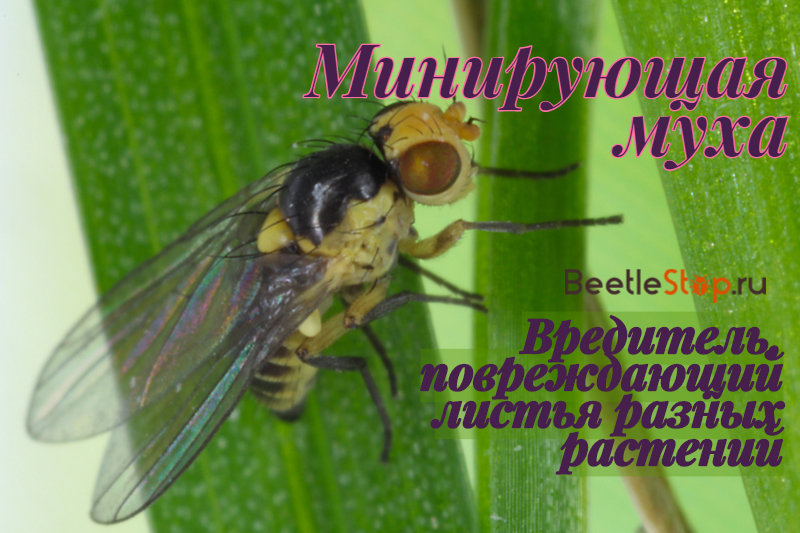What danger is a mining fly for the garden and how to deal with it?
The mining fly is one of the many pests attacking the garden. Therefore, each owner of a personal plot should know the enemy "in person." If an insect and traces of its activity are detected, then knowledge of methods for destroying the mineral will be useful.

What is this insect?
Mining flies (or flies) are a whole family of Agromyzidae (lat), which includes about 3,000 species. All of them are dipteran insects. These are small flies; in the structure, a massive thoracic section is clearly evident. Other distinctive features of the family are a wide abdomen, short legs and transparent wings, slightly sparkling in the sun.
The largest species diversity is noted by biologists in Germany. On the territory of this country there are 350 species of insect. In Russia, in regions with a temperate climate, they are much smaller - about 100. The most common of them:
- variegated - Liriomyza strigata;
- polyphagous - Phytomyza horticola;
- chrysanthemum leaf - Phytomyza syngenesiae;
- nightshade - Linomyza bryoniae, etc.
These species infect cultivated plants, harming agriculture and ornamental floriculture.
Insect life cycle
Flies are characterized by bisexual reproduction: individuals of different sexes mate, after which, after some time, the female makes masonry. She places her special organ - an ovipositor with a sharp end - deep into the leaf plate of plants. After such punctures, light green points remain on its surface, which fade over time. At the same time, only 15% of the created holes in the leaves are needed for masonry: all other injections serve to feed the adult individual of the mineral fly.
When 2 to 5 days pass, larvae appear. In order to grow and go to the next stage of development as soon as possible, they begin to eat intensely. To do this, the larvae gnaw the leaves of plants, creating in them a branched system of moves, which are called "mines". Hence the name of the whole family.
When the resources of one leaf are finished, the larva begins to move along the stem and branches of the plant in search of a new place for feeding. After 2 weeks, pupation begins. The larva gnaws at the surface of the leaf, crawls out and moves to the ground. There, under a thin layer of soil, it will become a chrysalis, from which a new fly will later emerge. The entire conversion cycle from an egg to an adult insect takes 25 days (at an air temperature of 20 ° C).
Pest Damage
These insects attack many cultivated plants. For example, you can often see a mining fly on cucumbers, on nightshade and cruciferous. Each puncture made by an adult, and the course, gnawed by hungry larvae, violates the integrity of the leaves of the victim plant. In addition, they feed on its nutritious juice.
All this leads to the fact that:
- bright spots can be seen on the leaves, often with necrosis of cells around;
- leaves gradually fade and fall;
- in bulbs, the bulb softens and decays;
- the plant slowly dies.
Due to leaf damage, their area involved in photosynthesis is reduced.In conjunction with the suction of cell juice by the larvae, the plant weakens, therefore, it becomes susceptible to various diseases.
Fighting the Mining Fly
To save planting and harvest, when infected with miner flies, you need as soon as possible get rid of individuals and their larvae. This will require treatment of plants with insecticides and folk remediescatching flying insects using traps. In order to secure crops grown in the garden in advance, you need to follow the recommendations for prevention.
Traps
A simple but effective way to destroy flying miner flies is to creating primitive trapscoated with a sticky layer. One option is special tapes sold in hardware stores. They are hung on a site near the beds and in greenhouses. Some gardeners make a trap on their own by painting a sheet of plywood, chipboard, linoleum, etc. in yellow and coating the surface with a sticky substance. For example, petroleum jelly or specially prepared adhesive solution.
If the infection is serious, then traps can not do: it's time to use chemicals.
Using pesticides
Against miner flies in agriculture, 2 classes of insecticides are used, which have proved their effectiveness in practice:
- Phosphorus compounds: these are BI-58, Zolon and others. Treatments with these funds are carried out with the onset of autumn, at a time when pests are looking for shelter for the winter. Typically, phosphorus-containing insecticides are used to spray fruit tree trunks and branches of a shrub.
- Neonicotinoids: the popular "Aktara", as well as "Confidor", "Mospilan" and others. They are suitable for small plants. They spray not only him, but also spill the earth around.
It is important to remember the toxicity of these drugs, including for humans. Therefore, it is necessary to use protective equipment in the work and follow the instructions to the tool. Particular attention is recommended to be paid to terms within which processing will be safe for vegetables and fruits.
If measures are taken in time, the mining fly will not have time to destroy a significant part of the leaves. Therefore, it is necessary to regularly inspect precipitation, and at the first "disturbing calls" to begin to act actively.


 (votes: 6, average rating: 4,83 out of 5)
(votes: 6, average rating: 4,83 out of 5)